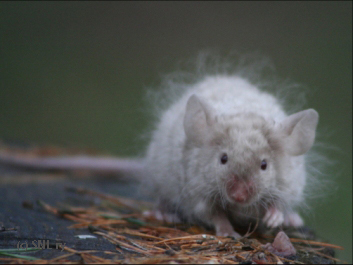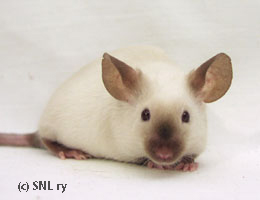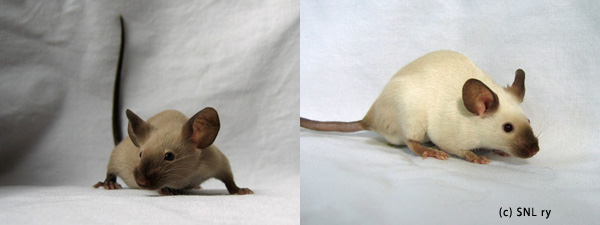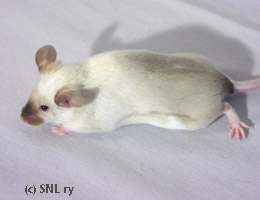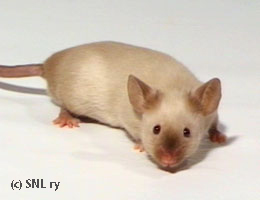Varieties
Shaded and Pointed
Siamese Seal Point (ssp)
a/a B/* ch/ch D/* P/*
"Eyes red. Body colour medium beige, gradually shaded over saddle and hind quarters, merging gradually with body colour and being darkest at the tail root. The belly should be as near as possible in colour and shading. Seal points (dark sepia) shall be present in the muzzle, ears, feet, tail and tail root. There should not be a definite or distinct line of demarcation but rather harmonious balance between body colour, shading and points. There should not be any blotches, streaks or white hairs."
Breeding information below the pictures.
Siamese seal point (ssp)
General info
Siamese is based on a gene called himalayan ch. The gene is recessive, which means that for siamese babies to be born, both parents need to be at least carriers of the gene. When homozygous on a black background (a/a B/* ch/ch D/* P/*) the phenotype is siamese seal point. When heterozygous with other C-locus recessives the gene produces other pointed varieties such as himalayan (ch/c), colorpoint beige (ce/ch) and burmese (cch/ch).
Siamese babies are often light cream coloured. Points start to develop after a few weeks and shadings may take several months to fully develop. As the mouse grows, points and shadings get darker and the body colour may become slightly lighter. Colour development is slower on mice of modest colour quality, and it may sometimes be difficult for an inexperienced breeder to identify 5-week-old siamese babies even as a pointed variety (this is the age mice are considered ready to move to new homes in Finland). Good quality siamese mice show clear points well before this age. In some cases the colour development happens in a reversed order: Small babies may be brownish grey, matching the colour of shadings on adult siamese. As the mouse grows the body colour becomes lighter and points appear. These mice have the strongest shadings as adult.
Siamese mice come in a huge variation of different shades, especially the body colour. Sometimes a siamese may be difficult to tell apart from himalayan, as on one extreme end of the scale the body colour may be white with no shadings. On the other extreme end the mouse may be light greyish brown with strong points and dark brown shadings.
Siamese colour is acromelanistic, meaning that it is affected by the surrounding temperature. The colouring tends to become darker as the temperature drops and lighter in warmer climates. For this reason the colour is sensitive to changes in temperature, and moults may introduce significant colour variation. When the mouse is moulting, siamese may show quite uneven colouring as shadings become patchy or stripy. This phase is normal and should pass when the moult is complete.
The eye colour of siamese mice is usually dark ruby. Very dark mice may have such dark eyes that they are almost black, but in a bright lighting the difference becomes clear. Although siamese have red eyes, it is genetically speaking a black eyed (P/*) variety; the ruby eye colour is caused by ch.
Breeding
Breeding siamese to siamese is usually the best choice and the breeder should pick mice with strong points and even body colour. A suitable outcross would be black with good pigmentation on its extremities.
What the breeder should especially avoid using are chocolate, all agouti based varieties and mice with the tan gene. Chocolate will sooner or later lead to siamese chocolate point which resembles seal point but has lighter and warmer shade overall. Siamese chocolate point is a nonstandardizable variety as it doesn't differ enough from seal point. A siamese with agouti gene (A/*) also resembles seal point a lot, but may have mealy body colour and its slightly lighter points show ticking under close inspection. The tan gene causes the belly colour to turn white with clear demarcation lines on the sides. Siamese seal point fox is considered nonstandardizable.
Common faults include light or partly lacking points (foot points are the most difficult to get right), a clearly lighter or white belly and uneven (patchy, stripy) colouring. Using a well pigmented black as outcross may help improve the points. Uneven colouring is a common problem during moults and there is little the breeder can do about it except keep the room temperature steady. On some mice patchy or stripy shadings are permanent. If the mouse has patchy or stripy colour when not moulting it should not be used for breeding, as this fault has shown to be inherited.
Siamese can be bred in the same line together with black, siamese blue point or colorpoint beige. Considering other pointed varieties, himalayan does not go together with siamese that well in the long run. The strong shadings required with siamese may show as light shadings on the himalayan, on which it is considered a fault. Himalayan should also have white body colour, which means that siamese from the same line would have too light body colour. With burmese the breeder faces a similar problem. For the burmese to have desired contrast between body colour and points, its body colour needs to be relatively light, whereas the siamese should have relatively dark body colour.
If the breeder can find extreme nonagouti mice (ae/ae), these are very suitable for breeding siamese. With this gene it is possible to get stunningly beautiful dark points.

